The Erik Buell you think you know—the former professional roadracer who competed alongside World Champions Kenny Roberts and Steve Baker at Daytona then started his own motorcycle company and eventually built more than 136,000 American sportbikes—is just one small slice of Buell's complex, multifaceted personality. And when Harley-Davidson discontinued Buell Motorcycles in 2009 and buried Buell's business—even restricting the right to use his eponymous company name—that seemed like all we'd ever know about this proud and some-times puzzling man.
But what seemed like his final act five years ago now looks like it was just a pit stop on the way to much bigger, better, and brighter future. Within days of being jettisoned by Harley-Davidson, Erik Buell Racing (EBR) was formed. EBR's first motorcycle, the hand-built, limited-production 1190RS, was the apogee of everything Buell knew about cutting-edge sportbike design. Now, two years later, the mass-production version of the exotic RS—the 2014 1190RX—establishes EBR as legitimate volume producer of American sportbikes. And sportbikes are just the beginning.
At the same time as he was getting EBR up and running, Erik Buell also established a contract-engineering consultancy that now exceeds his sportbike business both in size and scope. This led to a collaboration with Hero MotoCorp, India's largest motorcycle manufacturer, and this is what is going to transform Erik Buell from niche sportbike manufacturer to a major player in the upcoming global transportation revolution. Erik Buell Racing is now the chief technology provider to the megalithic Indian firm, designing not just sportbikes but entry-level commuters, scooters, electric hybrids, diesel-powered workhorses, and much, much more. This is where Erik Buell—and the rest of the like-minded team he has assembled—will really flex some innovation muscle.
Erik Buell, the speed-crazed racer, is still around and more relevant than ever. Witness the 1190RX, which recently made its World Superbike Championship racing debut. Now get ready to see even more facets of Erik Buell: the engineering impresario, the green-tech messiah, the personal-transportation revolutionary, and many more.
Erik Buell has always been a catalyst for change, but he's always operated under certain constraints. This time it's different. Completely untethered, he's surrounded himself with a building full of engineers just as unconventional and ingenious as he is. Backed by one of the world's most powerful—and hungriest—motorcycle manufacturers, Erik Buell is perfectly positioned to make his mark on a global scale.
Buell's first bike was constructed especially for AMA Formula 1 roadracing. Powered by a liquid-cooled, two-stroke, square-four from Barton (a British firm Buell actually purchased in 1981), it had a measured top speed of 178 mph. Buell sold just one bike in 1984 before the AMA abolished Formula 1 and made the RW750 obsolete, inspring him to focus on streetbikes.
Buell's first Harley-Davidson-powered motorcycle and first production streetbike featured an XR1000 engine mounted in a tubular-steel chassis using Buell's Uniplanar rubber-mounting system, his first significant engineering patent. Other Buell trademarks, such as the horizontally mounted under-engine shock, also debuted on this model. Just 50 RR1000s were built from 1987–'88.
Buell's second production model debuted in '88, utilizing Harley-Davidson's 1,203cc Evolution V-twin. The 1991 version seen here features single-seat bodywork, a five-speed transmission, standard Performance Machine-spun aluminum wheels, and a six-piston front brake with stainless steel line. Combined production of RS and RSS models totaled 325 through '93.
The first new model following the union between Buell and Harley-Davidson, the S2 Thunderbolt marked Buell's transition from cottage-industry special builder to legitimate mass-production motorcycle manufacturer. Using the same Uniplanar-mounted Evo motor in a modified version of the RS's tubular frameset, this was the first bike built in the East Troy manufacturing facility.
One of the most unusual production motorcycles ever, the S1 marries the tubular space frame of the Thunderbolt with minimalist streetfighter bodywork. Note the under-engine muffler, first employed by Buell in '85: "For years people said, 'What a stupid place for the muffler!'" Buell says. "Today, everyone does it!" A less-expensive naked, the M2 Cyclone, soon followed.
Erik Buell remains understandably proud of the Firebolt platform, which debuted nine major design patents, including fuel in the frame, oil in the swingarm, the rim-mounted brake, and more. This was the first done-from-scratch Buell that was not a derivative of the tube-framer. The Firebolt was the next leap forward for Buell. A naked S version was offered in addition to the half-faired R.
A liquid-cooled, Rotax-built V-twin made the 1125R the first non-Harley-Davidson-powered Buell since the RW750 in 1983. Bulbous, side-mounted radiators and now-familiar features like a fuel-bearing frame and inside-out front brake underlined Buell's "Different in Every Sense" tagline. It was a comfortable-if-quirky streetbike and a champion-ship-winning roadracer.
The first product from Erik Buell Racing, Buell's post-Harley-Davidson venture, the 1190RS was the laser-focused superbike that Harley-Davidson never allowed Buell to build. Powered by a highly tuned, big-bore version of the Helicon V-twin, the hand-built 1190RS weighed less than 400 pounds ready-to-ride and cost a staggering $43,000 with carbon-fiber bodywork.










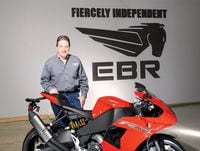
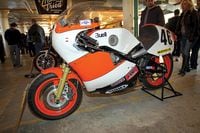

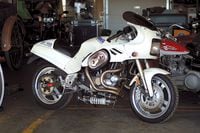

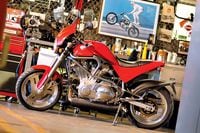

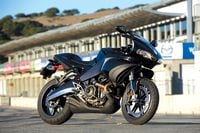

/cloudfront-us-east-1.images.arcpublishing.com/octane/S35YGSEMEZB4BLTDJTSZPF4GLA.jpg)
/cloudfront-us-east-1.images.arcpublishing.com/octane/5UOT6HPX2JFMRJAX6EH45AR4MQ.jpg)
/cloudfront-us-east-1.images.arcpublishing.com/octane/OKWOJWAKP5EP3OACCRRWPCIX2Q.jpg)
/cloudfront-us-east-1.images.arcpublishing.com/octane/2WF3SCE3NFBQXLDNJM7KMXA45E.jpg)
/cloudfront-us-east-1.images.arcpublishing.com/octane/G4MG6OUCJNBSHIS2MVVOTPX65E.jpg)
/cloudfront-us-east-1.images.arcpublishing.com/octane/IIGGWFOTOJGB7DB6DGBXCCMTDY.jpg)
/cloudfront-us-east-1.images.arcpublishing.com/octane/QSTCM6AVEZA5JJBUXNIQ3DSOF4.jpg)
/cloudfront-us-east-1.images.arcpublishing.com/octane/U4I7G625B5DMLF2DVIJDFZVV6M.jpg)
/cloudfront-us-east-1.images.arcpublishing.com/octane/B6XD6LS6IVCQPIU6HXDJSM3FHY.jpg)
/cloudfront-us-east-1.images.arcpublishing.com/octane/ICL63FEDDRDTTMINYICCEYGMDA.jpg)
/cloudfront-us-east-1.images.arcpublishing.com/octane/FCGZHQXRBZFLBAPC5SDIQLVF4I.jpg)
/cloudfront-us-east-1.images.arcpublishing.com/octane/WNOB6LDOIFFHJKPSVIWDYUGOPM.jpg)

/cloudfront-us-east-1.images.arcpublishing.com/octane/X33NU3E525ECRHXLNUJN2FTRKI.jpg)
/cloudfront-us-east-1.images.arcpublishing.com/octane/6KKT5NNL2JAVBOXMZYS5ZO76YA.jpg)
/cloudfront-us-east-1.images.arcpublishing.com/octane/J5RKG5O455GMPGQRF2OG6LRT7A.jpg)
/cloudfront-us-east-1.images.arcpublishing.com/octane/GX2CIZKQVRH2TATDM26KFG2DAE.jpg)
/cloudfront-us-east-1.images.arcpublishing.com/octane/ZWIDYSAKQZHD5BHREMQILXJCGM.jpg)
/cloudfront-us-east-1.images.arcpublishing.com/octane/CYUHJZCTSJCH3MRAQEIKXK7SCQ.jpg)
/cloudfront-us-east-1.images.arcpublishing.com/octane/LKOFINY56FCXJCANJ5M7ZDQUBY.jpg)
/cloudfront-us-east-1.images.arcpublishing.com/octane/4NBPDACMWJH63JQYJVK3QRBDZI.jpg)
/cloudfront-us-east-1.images.arcpublishing.com/octane/KKHQHRR3FJGX7H2IPU6RALMWG4.jpg)

/cloudfront-us-east-1.images.arcpublishing.com/octane/5IOFS5JAE5FOXMNA23ZRAVVYUU.jpg)